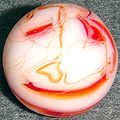-
Posts
12128 -
Joined
-
Days Won
324
Content Type
Profiles
Forums
Gallery
Events
Everything posted by Ric
-
You're pretty chatty there today, Art. 🤣
-
I think that is an Asian marble, often referred to as an Imperial - pretty nice one too.
-
Bull's Eye Chinas produced in Germany - nice find.
-
That looks like a German hand-made glass game marble or ballot ball to me.
-
It's looks Master or Akro to me but the photos are too blurry to tell which.
- 1 reply
-
- 1
-

-
I believe these are all veneered Vitros - Conquerors or variants.
-
The fractures are unfortunate. My first thought is Ravenswood but the details are blurry so it's a little hard to tell. What size is it?
- 1 reply
-
- 1
-

-

The "Score!" thread. Post your exciting finds here...
Ric replied to bumblebee's topic in General Marble & Glass Chat
Nice, you obviously have much better hunting grounds than I do around here. I haven't seen a group in the wild like that for years and years. Luck you! -
I'll actually call @ROSIEonFIRE for you, Fire. They may not even notice the lounge. 🙂
-
Cool beans - some Akros can be loaded with the stuff, green AV is the most common but it can come in a few different colors.
-

2 green swirls. ⅝" and slightly over ⅝"
Ric replied to marblemanvintagemarbles's topic in Marble I.D.'s
They look like a game marbles with a little extra color - there's a hint of blue in there too. I'd lean Alley over Champion. Game marbles still have the pattern of their producer. Some folks call the nicer ones "Monochromes". I've seen some Alleys with great flames. -
Just a run-of-the-mill Vitro patch, IMO.
-
Maybe it was supposed to be a Corkscrew and it's just messy.
-
It does look like it could be an aberrant onyx with waaay more than it's fair share of white. Lazy suggests it just doesn't spiral well. This one looks like it spirals plenty, at least to me. It just looks like there is little or no separation between the spirals. I think this one is just an error. The tracer looks like just a bit of stray color and probably not intentional.
-

What in the World is this? I do not have measurement! Thank you!
Ric replied to Madcap Laughs's topic in Marble I.D.'s
I could see it being an Akro game marble but I think it's hard to know for sure what company made it since many produced tons of "clearies". -
At that size, I'd say MFC too - maybe produced for an industrial purpose like pump valve balls.
- 1 reply
-
- 1
-

-

What in the World is this? I do not have measurement! Thank you!
Ric replied to Madcap Laughs's topic in Marble I.D.'s
It's been a while since I've been in the neighborhood and I'm old enough to remember when Nick Fink's was a dive. lol I still get up to Rockford regularly to visit family though. -
Yes, that's a Rainbo.
-

What in the World is this? I do not have measurement! Thank you!
Ric replied to Madcap Laughs's topic in Marble I.D.'s
It doesn't impress me as handmade marble. It looks more like a weird "cold roll" defect on a machine made marble. Comstock Park, huh. I've been in Nick Fink's more than a few times - born and raised in NE GR. -
If there is a little indented line you can feel with your fingernail where I circled I am changing my ID to Master. 🙂
-
Looks like an Akro moss agate to me.
-
I'm leaning toward Akro. If that is AV it should glitter in sunlight - roll it around a bit and see if it sparkles.
-

Very nice 11/16" Slag Not Your Normal Slag
Ric replied to marblemanvintagemarbles's topic in Marble I.D.'s
It looks hand gathered to me but being white on clear makes it hard to see detail. It doesn't impress me as MFC, the pattern looks more Navarre to me but I really can't tell. Can you get a nice strait-on close-up of this area? Does it look like there is a pontil or seam there? -
Cleaning it wouldn't hurt, although it might not help too much. Like Fire said, it looks to be mostly pocket-wear - just mild surface abrasions. The thing is quite old after all. Who knows what it's been through? Start off by just giving it a bath with room temp water and some dish soap. A soft brush would be okay but be careful around any damage and don't use a wire brush or anything too harsh or abrasive. You never know, it might help a little.





